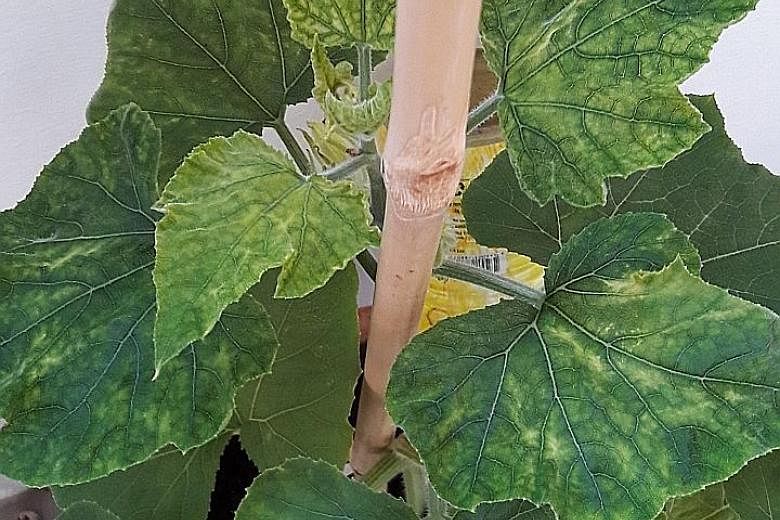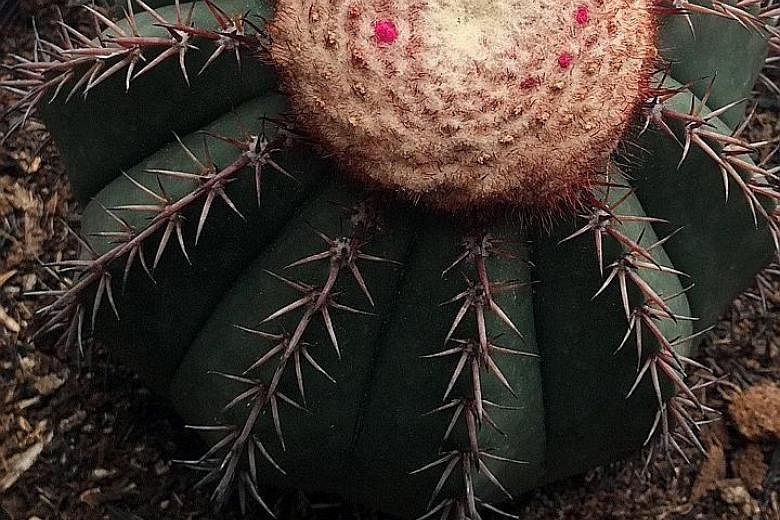Check soil pH of pumpkin plant for nutrient deficiency
The leaves of my pumpkin plant are white and light green, instead of dark green. I feed the plant fertiliser, hoping to get darker leaves, but to no avail. Also, the tips of its underdeveloped flower buds turn brown. The plant gets the morning sun and I water it twice a day. It does not produce new leaves. What is wrong with it?
Neo Lau Choo
Several issues may be affecting your pumpkin plant.
To determine if it is suffering from a nutrient deficiency, conduct a soil pH test to measure the acidity and alkalinity. pH levels range from 0 to 14, with 7 being neutral, below 7 acidic and above 7 alkaline. The ideal soil pH for growing pumpkins is between 5.5 and 7.5.
A review of the soil type, its pH and fertiliser regimen needs to be done together to get a better picture of the situation.
An incorrect soil pH means the plant will not be able to absorb any nutrients that are added to the soil.
Once the pH of the soil has been corrected, you can use a water-soluble fertiliser to resolve nutrient deficiency quickly.
The plant's young leaves appear distorted. Check if they are being attacked by sucking insects such as aphids. These pests can spread incurable viral diseases to the plant. If the plant is infected, throw it away. All cutting tools used on the plant also need to be sterilised.
White Bat Lily is native to Singapore
I saw this plant at Bukit Timah Hill. What is it?
Seow Hong Chua
It is the White Bat Lily and is known botanically as Tacca integrifolia. It is native to Singapore and can be found in nature reserves.
This species is different from the Black Bat Lily (its botanical name is Tacca chantrieri).
The White Bat Lily has floral bracts which are upright and look like rabbit ears. The bracts should be whiter towards the top.
The plant prefers to be grown in a protected, humid area where it can get filtered sunlight.
It should be grown in soil that is rich in organic matter and leaf litter.
Pink growths are cactus' fruit
My five-year-old cactus started flowering last month. The flowers usually bloom in the late afternoon and wither by the morning. Last week, pink growths started appearing. Are these its fruit?
Tuck Sum Leong
The cactus is botanically known as Melocactus conoideus.
It is categorised as "critically endangered" in its natural habitat as its population is in continual decline. However, its species is commonly cultivated.
This cactus species, like others in the same genus, has a cap-like cephalium - a woolly, bristly swelling at the top or side of certain cactus species - and is commonly called Turk's Cap Cactus.
The pink structures that grow from the cephalium are its fruit.
Cannonball Tree has an unusual flowering and fruiting habit
What is this tree, which has pink flowers?
Angelia Goh
The tree is commonly known as the Cannonball Tree. Its botanical name is Couroupita guianensis.
It produces thick, long and twisted stalks of large, showy and fragrant flowers. Its fruit is large and round - resembling a cannon ball. This is an unusual flowering and fruiting habit called cauliflory.
The fruit has a smelly red pulp, so it is not usually eaten. The tree is not often grown any more as its falling fruit can hurt people.
Rosemary has root rot
A friend gave me a pot of rosemary and I put it on my balcony, where it is sunny and windy. I water it once a day. After a month, its leaves turned brown. What happened?
Joe Hioa
The rosemary plant is likely to be affected by root rot. There is very little you can do to save the plant once root rot has set in. The roots no longer take in water, so the aerial parts of the plant are slowly drying up and will die.
This issue is prevalent in tropical, humid Singapore, especially when the plant is grown in a medium that retains too much moisture. Imported plants are often potted up in a peat-or coconut peat-based medium that is too moisture-retentive.
But do not change the medium, as the plant will experience transplant shock and subsequently decline. Instead, take tip cuttings and root them in coarse sand or gravel. Once the cuttings root, you can pot them in a soil mix of coarse components such as fine, expanded clay pellets and pumice.
Mix in some burnt earth and good quality compost. Such a mix will be free-draining and can be tailored to different growing environments.
The plant should be allowed to dry out a little before watering. Place the pot in a sheltered location, where it is protected from torrential rains.
•Answers by Dr Wilson Wong, a certified practising horticulturist and founder of Green Culture Singapore (www.greenculturesg.com). He is also an NParks-certified park manager.
•Have a gardening query? E-mail it with clear, high-resolution pictures of at least 1MB, if any, and your full name to stlife@sph.com.sg





